In this guide, we will explore the past simple tense, its uses, and the necessary information to help you understand and master it. We’ll cover completed actions in the past, past habits, situations that were true in the past, and events in chronological order. After that, we’ll provide 25 practice questions to test your understanding of the past simple tense, with correct answers and explanations at the end.
Completed actions in the past
The past simple tense is used to describe actions or events that happened in the past, with a specific time either mentioned or implied. These actions are completed, and there is no connection to the present.
Examples:
- I met Sarah last week. (The meeting happened in the past and is finished.)
- They finished the project on time. (The project was completed in the past.)
- He visited London last summer. (The visit took place in the past and is over.)
Past habits
The past simple tense is used to talk about past habits or actions that occurred regularly or repeatedly in the past. These habits are no longer true in the present.
Examples:
- He exercised every morning before work. (He no longer exercises every morning.)
- She taught English at a local school. (She doesn’t teach English there anymore.)
- We used to go for a walk every evening. (We don’t go for walks every evening now.)
Situations that were true in the past
The past simple tense is used to describe situations, facts, or states that were true in the past but are no longer true in the present.
Examples:
- My great-grandmother spoke four languages. (She is no longer alive.)
- She grew up in a small village. (She doesn’t live in that village now.)
Events in chronological order
The past simple tense is used to describe the main events of a story in chronological order, showing a sequence of actions that occurred in the past.
Example:
- After I got home, I changed my clothes, and then I started cooking dinner. (The actions happened one after the other in the past.)
Forming the past simple tense
The past simple tense is formed by adding -ed to the base form of regular verbs. For example, “work” becomes “worked” and “dance” becomes “danced.” However, there are many irregular verbs in English that have unique past simple forms, such as “go” (went), “eat” (ate), and “sing” (sang).
Practice Questions:
Last week, they ______ (move) to a new house.
a. moved
b. were moving
c. will move
She ______ (study) French when she was in high school.
a. studied
b. was studying
c. will study
Yesterday, it ______ (rain) heavily in the morning.
a. rained
b. was raining
c. will rain
We ______ (have) dinner together every Sunday in the past.
a. had
b. were having
c. will have
He ______ (write) a letter to his friend two days ago.
a. wrote
b. was writing
c. will write
Correct Answers and Explanations:
- Correct answer: a. moved
Explanation: The past simple tense is used to describe completed actions in the past. In this case, moving to a new house is a completed action that happened last week. - Correct answer: a. studied
Explanation: The past simple tense is used to talk about past habits. Studying French in high school is a past habit that is no longer true in the present. - Correct answer: a. rained
Explanation: The past simple tense is used to describe completed actions in the past. The heavy rain in the morning is a completed action that happened yesterday. - Correct answer: a. had
Explanation: The past simple tense is used to talk about past habits. Having dinner together every Sunday is a past habit that is no longer true in the present. - Correct answer: a. wrote
Explanation: The past simple tense is used to describe completed actions in the past. Writing a letter to a friend is a completed action that happened two days ago.
